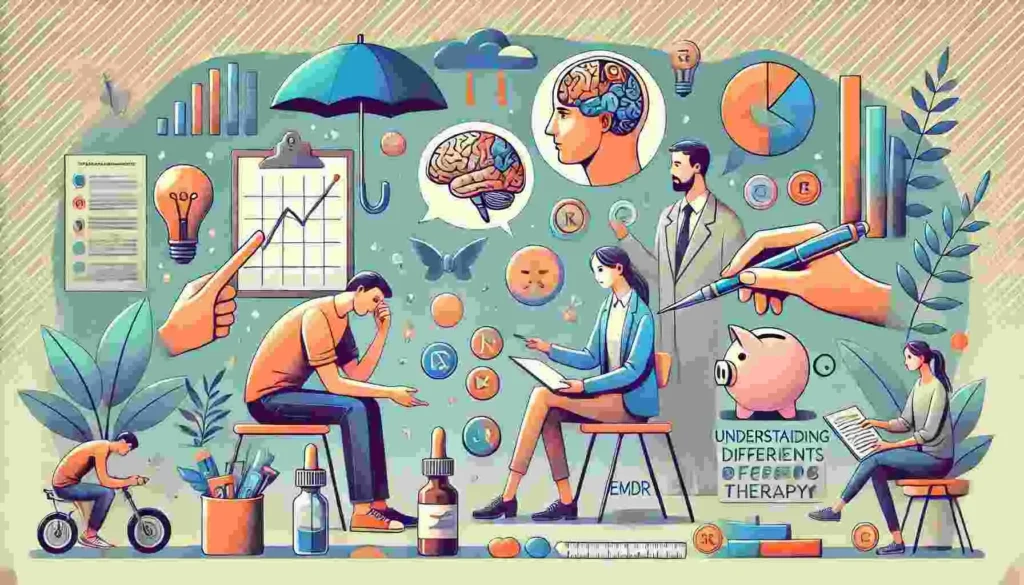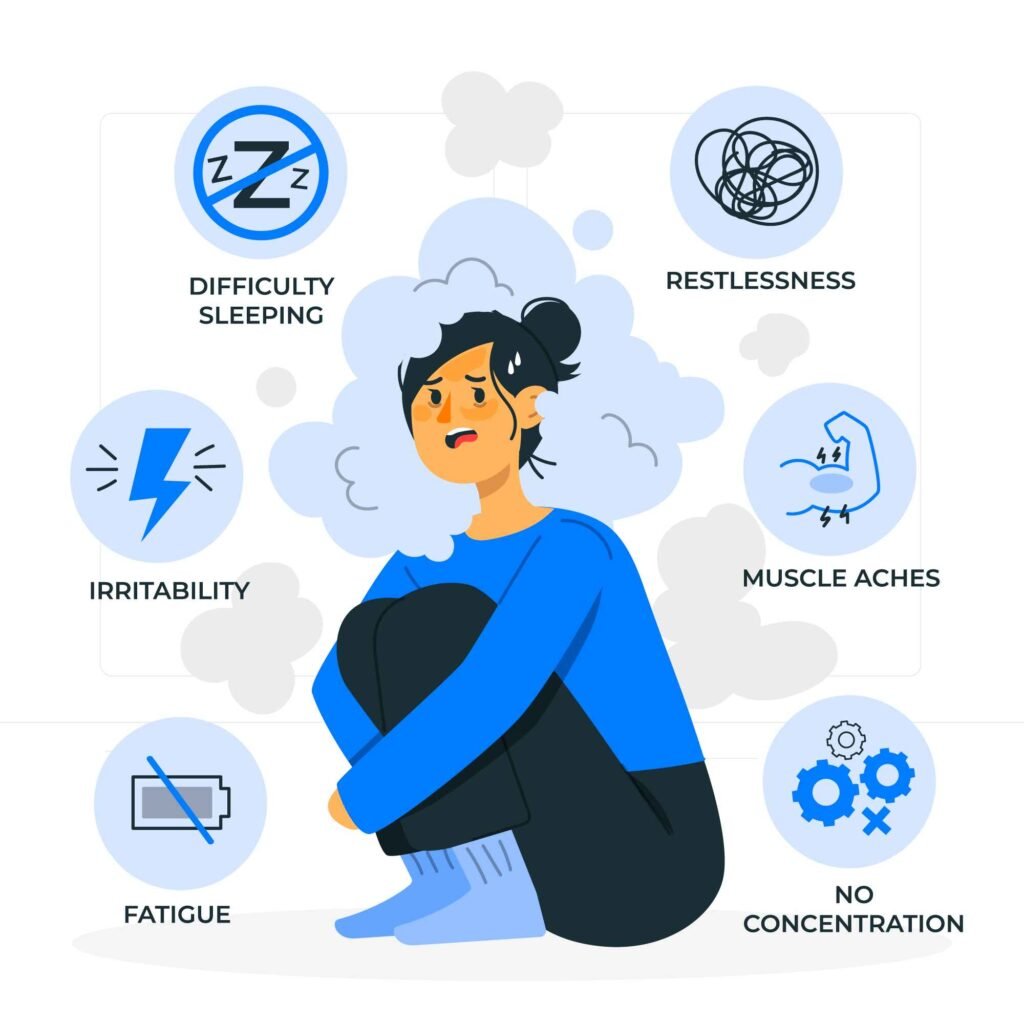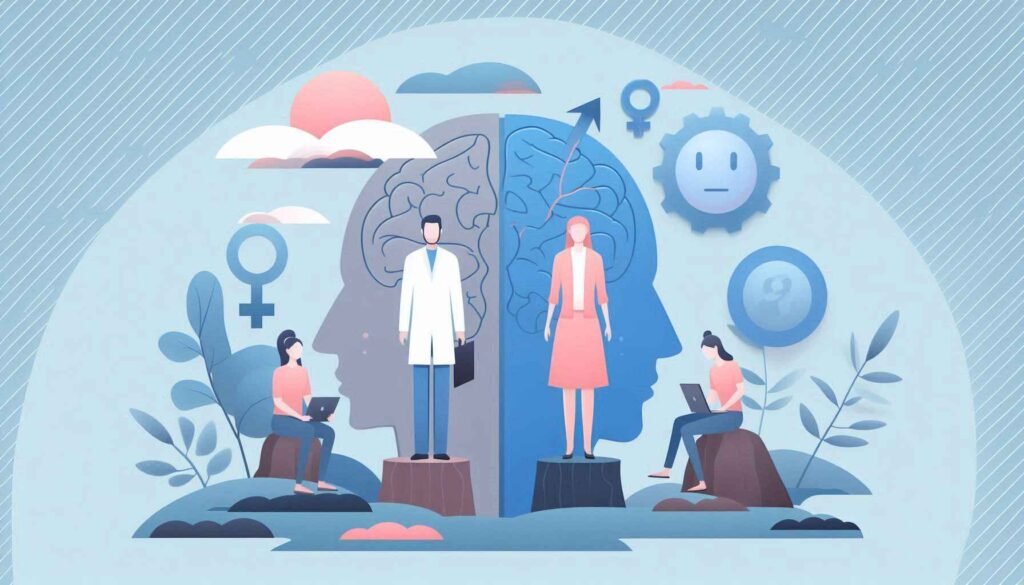
Understanding Different Types of Therapy: A breakdown of various therapeutic approaches such as DBT, EMDR, and more
Therapy is a powerful tool for addressing mental health challenges, fostering personal growth, and improving overall well-being. With the growing awareness of mental health, understanding different therapeutic approaches can help individuals find the most effective method for their needs. This guide explores key therapy types, including Dialectical Behavior Therapy (DBT), Eye Movement Desensitization and Reprocessing (EMDR), and others, highlighting their unique benefits and applications.
What Is Therapy and Why Is It Important?
Therapy, or psychotherapy, is a collaborative process between a trained therapist and a client aimed at addressing psychological and emotional issues. It provides a safe space for individuals to explore their thoughts, feelings, and behaviors. Therapy helps people overcome challenges, develop coping strategies, and enhance their quality of life.
Dialectical Behavior Therapy (DBT): Emotional Regulation and Mindfulness
DBT is a specialized form of Cognitive Behavioral Therapy (CBT) developed by Dr. Marsha Linehan. Originally designed to treat borderline personality disorder (BPD), DBT is now widely used to address other mental health concerns, including anxiety, depression, and post-traumatic stress disorder (PTSD).
Core Components of DBT:
- Mindfulness: Teaches individuals to stay present in the moment without judgment.
- Distress Tolerance: Focuses on managing crises without making impulsive decisions.
- Emotional Regulation: Helps individuals identify and manage intense emotions.
- Interpersonal Effectiveness: Improves communication and relationship-building skills.
Who Benefits from DBT? DBT is especially effective for individuals struggling with intense emotions, self-harm, or suicidal thoughts. Its structured approach offers tangible skills to navigate life’s challenges.
Eye Movement Desensitization and Reprocessing (EMDR): Healing from Trauma
EMDR is a trauma-focused therapy developed by Francine Shapiro. It is designed to help individuals process and resolve distressing memories, particularly those associated with PTSD.
How EMDR Works: EMDR involves the use of bilateral stimulation, such as side-to-side eye movements, to reprocess traumatic memories. This helps desensitize emotional responses and integrate the memory into a healthier perspective.
Applications of EMDR:
- PTSD and trauma recovery
- Anxiety and panic disorders
- Grief and loss
- Phobias
Effectiveness of EMDR: Research shows that EMDR can provide significant relief from trauma-related symptoms in a shorter time compared to traditional talk therapies.
Cognitive Behavioral Therapy (CBT): Changing Thought Patterns
CBT is one of the most widely practiced and researched forms of therapy. It focuses on identifying and changing negative thought patterns and behaviors that contribute to psychological distress.
Principles of CBT:
- Thoughts influence emotions and behaviors.
- Challenging irrational beliefs can lead to healthier outcomes.
- Behavioral changes reinforce positive thought patterns.
Who Can Benefit? CBT is effective for a range of conditions, including depression, anxiety disorders, and substance abuse. Its structured, goal-oriented approach appeals to individuals seeking practical solutions.
Acceptance and Commitment Therapy (ACT): Embracing Life’s Challenges
ACT is a mindfulness-based therapy that encourages individuals to accept their experiences rather than avoid or fight them. It aims to align behaviors with personal values and foster psychological flexibility.
Key Components of ACT:
- Acceptance: Acknowledging thoughts and feelings without judgment.
- Defusion: Creating distance from negative thoughts to reduce their impact.
- Values Identification: Clarifying what truly matters in life.
- Committed Action: Taking steps toward meaningful goals despite challenges.
Applications of ACT: ACT is beneficial for individuals dealing with chronic pain, stress, and mood disorders. Its emphasis on values-driven action helps people live more fulfilling lives.
Psychodynamic Therapy: Uncovering the Unconscious
Rooted in Freudian theory, psychodynamic therapy explores unconscious processes and past experiences that influence current behavior. It focuses on self-awareness and understanding deep-seated emotional conflicts.
Techniques in Psychodynamic Therapy:
- Free association: Encouraging clients to express thoughts without censorship.
- Dream analysis: Exploring the symbolic meaning of dreams.
- Transference: Understanding emotions transferred to the therapist.
Who Benefits from Psychodynamic Therapy? Individuals seeking long-term personal growth and insight into their behavior often find psychodynamic therapy transformative.
Group Therapy: Healing Through Shared Experiences
Group therapy involves a small group of individuals working together under the guidance of a therapist. It provides a supportive environment where participants can share experiences, gain insights, and practice social skills.
Benefits of Group Therapy:
- Reduced isolation and stigma
- Opportunities for feedback and perspective-sharing
- Building a sense of community and belonging
Common Uses: Group therapy is effective for addressing substance abuse, grief, and social anxiety. It complements individual therapy by offering diverse viewpoints and support.
Choosing the Right Therapy for You
Finding the right therapeutic approach depends on individual needs, preferences, and the specific challenges being addressed. Consulting with a qualified therapist can help determine the best fit. Understanding Different Types of Therapy: A Breakdown of Various Therapeutic Approaches (Part 2)
In the first part of this guide, we explored Dialectical Behavior Therapy (DBT), Eye Movement Desensitization and Reprocessing (EMDR), Cognitive Behavioral Therapy (CBT), Acceptance and Commitment Therapy (ACT), Psychodynamic Therapy, and Group Therapy. Now, let’s dive into more therapeutic approaches to help you discover the method that resonates best with your needs.
Humanistic Therapy: Emphasizing Self-Growth and Potential
Humanistic therapy is a holistic approach that focuses on personal growth, self-awareness, and fulfilling one’s potential. It operates on the belief that every person has an innate ability to achieve their goals and lead a meaningful life.
Core Principles of Humanistic Therapy:
- Self-Actualization: Striving to reach your highest potential.
- Empathy: The therapist offers deep understanding and non-judgmental support.
- Unconditional Positive Regard: Accepting clients fully, regardless of their thoughts or behaviors.
Types of Humanistic Therapy:
- Person-Centered Therapy: Developed by Carl Rogers, this approach empowers clients to take the lead in their sessions.
- Gestalt Therapy: Focuses on the present moment and helps individuals understand their feelings and actions.
- Existential Therapy: Explores life’s meaning, freedom, and responsibility.
Who Benefits from Humanistic Therapy? This therapy is ideal for individuals seeking self-discovery, personal development, and greater self-esteem. It’s especially effective for those dealing with life transitions, identity issues, or existential concerns.
Narrative Therapy: Rewriting Your Story
Narrative therapy focuses on the stories people tell about their lives. Developed by Michael White and David Epston, this approach helps individuals separate themselves from their problems by seeing issues as external entities rather than inherent parts of their identity.
Key Techniques in Narrative Therapy:
- Externalization: Seeing the problem as something outside yourself (e.g., “anxiety” rather than “I am anxious”).
- Re-Authoring: Creating new, empowering stories that reflect strengths and values.
- Unique Outcomes: Identifying times when the problem did not dominate, highlighting resilience.
Applications of Narrative Therapy:
- Trauma recovery
- Anxiety and depression
- Identity and self-esteem issues
Why Choose Narrative Therapy? If you feel defined by your problems or trapped by negative life stories, narrative therapy can empower you to create a new narrative of hope and strength.
Solution-Focused Brief Therapy (SFBT): Fast-Tracking Positive Change
SFBT is a goal-oriented, short-term therapy developed by Steve de Shazer and Insoo Kim Berg. Unlike traditional therapies that focus on problems, SFBT emphasizes finding solutions and achieving specific goals.
Core Elements of SFBT:
- Miracle Question: Imagining how life would look if the problem were solved.
- Scaling Questions: Assessing progress and setting achievable goals.
- Exception Seeking: Identifying times when the problem didn’t occur and understanding why.
Benefits of SFBT:
- Quick and effective for individuals seeking immediate solutions.
- Focuses on strengths and resources.
- Encourages a positive, forward-thinking mindset.
Who Can Benefit? SFBT is ideal for those dealing with relationship issues, work-related stress, or life transitions. It works well for people who prefer a structured and efficient approach.
Somatic Experiencing: Healing Trauma Through the Body
Developed by Dr. Peter Levine, Somatic Experiencing (SE) focuses on the connection between the mind and body to heal trauma. It operates on the principle that trauma is stored in the body and can lead to physical and emotional symptoms.
How Somatic Experiencing Works:
- Body Awareness: Noticing bodily sensations and tension.
- Pendulation: Alternating between distressing sensations and feelings of safety.
- Titration: Processing trauma in small, manageable doses.
Applications of Somatic Experiencing:
- PTSD and trauma recovery
- Chronic stress
- Physical symptoms related to trauma (e.g., headaches, muscle pain)
Why Consider SE? If you feel disconnected from your body or experience physical symptoms linked to trauma, SE offers a holistic approach to healing.
Art Therapy: Expressing Emotions Creatively
Art therapy combines creative expression with psychological insight. It helps individuals process emotions and experiences through artistic activities like drawing, painting, or sculpture.
Core Concepts of Art Therapy:
- Nonverbal Communication: Expressing feelings that are hard to put into words.
- Symbolism: Using art to explore deeper meanings and unconscious thoughts.
- Self-Exploration: Gaining insights through creative expression.
Who Can Benefit? Art therapy is effective for children, teens, and adults dealing with trauma, anxiety, depression, or developmental disorders. It provides a non-judgmental space for self-expression.
Play Therapy: Healing Through Play for Children
Play therapy is a specialized form of therapy designed for children. Through play, children can express emotions, process experiences, and develop coping skills.
Types of Play Therapy:
- Directive Play Therapy: The therapist guides the child through specific activities.
- Non-Directive Play Therapy: The child takes the lead, allowing spontaneous expression.
Common Techniques:
- Puppets and dolls
- Sand tray therapy
- Storytelling and role-playing
Benefits of Play Therapy:
- Helps children process trauma, anxiety, and behavioral issues.
- Encourages communication in a way children understand.
Integrative Therapy: A Customized Approach
Integrative therapy combines techniques from various therapeutic models to meet individual needs. Therapists draw from multiple approaches like CBT, psychodynamic therapy, and mindfulness to create a personalized plan.
Why Choose Integrative Therapy?
- Flexibility to address complex issues.
- Tailored to your unique personality and goals.
- Holistic approach to mind, body, and emotions.
Finding the Right Therapist
Choosing the right therapist is crucial for your mental health journey. Here are a few tips to help you decide:
- Identify Your Needs: Determine what challenges you want to address.
- Research Therapists: Look for licensed professionals with experience in your area of concern.
- Ask Questions: Inquire about their approach, techniques, and experience.
- Trust Your Instincts: Choose someone you feel comfortable with.
Understanding Different Types of Therapy: A Breakdown of Various Therapeutic Approaches (Part 3)
In the first two parts of this guide, we explored therapeutic approaches such as Dialectical Behavior Therapy (DBT), Eye Movement Desensitization and Reprocessing (EMDR), Cognitive Behavioral Therapy (CBT), Narrative Therapy, and more. In this final part, we’ll cover additional approaches like Family Therapy, Music Therapy, Animal-Assisted Therapy, and more, helping you find the method that best fits your journey toward mental health and well-being.
Family Therapy: Strengthening Family Dynamics
Family therapy focuses on improving communication and resolving conflicts within family systems. Rather than viewing issues as solely individual, this approach addresses how family dynamics influence behavior and emotional well-being.
Core Techniques in Family Therapy:
- Structural Therapy: Reshaping family interactions to create healthier boundaries.
- Systemic Therapy: Examining family roles and patterns to identify the root of conflicts.
- Strategic Therapy: Implementing problem-solving strategies to address specific issues.
Benefits of Family Therapy:
- Resolves parent-child conflicts.
- Improves communication between family members.
- Supports families dealing with addiction, divorce, or grief.
Who Can Benefit? Families experiencing tension, communication breakdowns, or major life transitions can find this approach transformative.
Music Therapy: Healing Through Sound and Rhythm
Music therapy uses music to address physical, emotional, cognitive, and social needs. It involves listening to, creating, or analyzing music under the guidance of a trained music therapist.
Techniques in Music Therapy:
- Active Music-Making: Playing instruments or singing to express emotions.
- Receptive Music Therapy: Listening to music to evoke relaxation or reflection.
- Songwriting: Creating lyrics that convey personal experiences or struggles.
Applications of Music Therapy:
- Reducing anxiety and depression.
- Enhancing cognitive function in individuals with dementia.
- Supporting emotional expression in children and teens.
Why Choose Music Therapy? If traditional talk therapy feels challenging, music therapy offers a creative and engaging alternative for self-expression and healing.
Animal-Assisted Therapy: The Power of the Human-Animal Bond
Animal-assisted therapy (AAT) involves interactions with trained animals to improve mental and emotional well-being. Common therapy animals include dogs, horses, and even cats.
How AAT Works:
- Emotional Support: Animals provide comfort, companionship, and a sense of calm.
- Building Trust: Interacting with animals can help individuals develop trust and social skills.
- Physical Activity: Activities like walking a therapy dog or horseback riding can improve physical health and coordination.
Benefits of AAT:
- Reduces anxiety and PTSD symptoms.
- Enhances mood and lowers stress.
- Increases motivation and social engagement.
Who Can Benefit? AAT is effective for children with autism, individuals with PTSD, and those struggling with loneliness or depression.
Mindfulness-Based Stress Reduction (MBSR): Cultivating Presence and Peace
Developed by Dr. Jon Kabat-Zinn, MBSR is an evidence-based program that uses mindfulness practices to reduce stress and improve well-being. It blends meditation, body scans, and gentle yoga.
Core Practices in MBSR:
- Body Scan: Bringing awareness to physical sensations from head to toe.
- Mindful Breathing: Focusing on the breath to anchor the mind in the present.
- Mindful Movement: Gentle yoga to integrate mindfulness with physical activity.
Benefits of MBSR:
- Reduces chronic stress and anxiety.
- Improves sleep quality.
- Enhances emotional resilience and focus.
Who Can Benefit? Anyone experiencing stress, anxiety, or chronic pain can find relief through MBSR.
Gestalt Therapy: Focusing on the Here and Now
Gestalt therapy emphasizes present-moment awareness and personal responsibility. Developed by Fritz Perls, this approach helps individuals understand how unresolved issues from the past affect their current behavior.
Key Techniques in Gestalt Therapy:
- Empty Chair Technique: Speaking to an imaginary person or part of yourself to resolve conflicts.
- Role-Playing: Acting out scenarios to gain insight and perspective.
- Awareness Exercises: Noticing thoughts, emotions, and bodily sensations in the moment.
Benefits of Gestalt Therapy:
- Increases self-awareness and emotional clarity.
- Helps process unresolved trauma or conflicts.
- Encourages personal growth and authenticity.
Who Can Benefit? Individuals looking to break free from negative patterns and increase self-understanding can benefit from Gestalt therapy.
Psychodrama: Acting Out Emotions and Experiences
Psychodrama is an experiential therapy developed by Jacob Moreno. It uses role-playing and dramatic techniques to explore personal and social issues in a group setting.
Core Elements of Psychodrama:
- The Stage: A safe space where individuals reenact experiences.
- The Protagonist: The person whose story is being explored.
- The Director: The therapist guiding the process.
Benefits of Psychodrama:
- Provides new perspectives on challenging situations.
- Facilitates emotional expression and release.
- Builds empathy and connection within groups.
Who Can Benefit? People who enjoy creative, action-oriented therapies or struggle to express emotions through traditional talk therapy.
Hypnotherapy: Unlocking the Subconscious Mind
Hypnotherapy uses guided relaxation and focused attention to achieve a heightened state of awareness known as hypnosis. In this state, individuals are more open to positive suggestions and insights.
Applications of Hypnotherapy:
- Overcoming phobias and fears.
- Managing chronic pain.
- Reducing stress and anxiety.
- Supporting behavior change (e.g., smoking cessation).
How Hypnotherapy Works: The therapist guides you into a relaxed state and uses suggestions to help reframe thoughts, emotions, or behaviors.
Why Consider Hypnotherapy? If you’re looking for a way to tap into your subconscious mind and create lasting change, hypnotherapy can be a powerful tool.
Dance/Movement Therapy: Expressing Emotions Through Movement
Dance/Movement Therapy (DMT) uses movement and dance to promote emotional, social, cognitive, and physical integration. It is based on the idea that the mind and body are interconnected.
Core Techniques in DMT:
- Improvisational Dance: Free-form movement to express feelings.
- Mirror Exercises: Reflecting a partner’s movements to build connection.
- Grounding Techniques: Using physical movement to reconnect with the present moment.
Benefits of DMT:
- Releases pent-up emotions and stress.
- Enhances body awareness and self-esteem.
- Promotes relaxation and emotional well-being.
Who Can Benefit? DMT is suitable for individuals of all ages dealing with trauma, anxiety, depression, or body image issues.
Finding the Right Therapy for Your Journey
With so many therapeutic approaches available, finding the right fit can seem overwhelming. Here are some steps to help you choose the best therapy for your needs:
- Identify Your Goals: Are you looking to heal trauma, reduce anxiety, or improve relationships?
- Research Therapies: Explore different methods to see which aligns with your goals.
- Consult a Therapist: A professional can guide you toward the most effective approach.
- Stay Open-Minded: You might benefit from trying a combination of therapies.
Final Thoughts
Understanding the various types of therapy empowers you to take control of your mental health journey. Whether you resonate with talk therapies like CBT and DBT, creative approaches like art therapy and psychodrama, or body-based methods like somatic experiencing, there’s a path to healing and growth that’s right for you. Remember, seeking help is a sign of strength, and the right therapy can unlock new levels of well-being and self-discovery.



